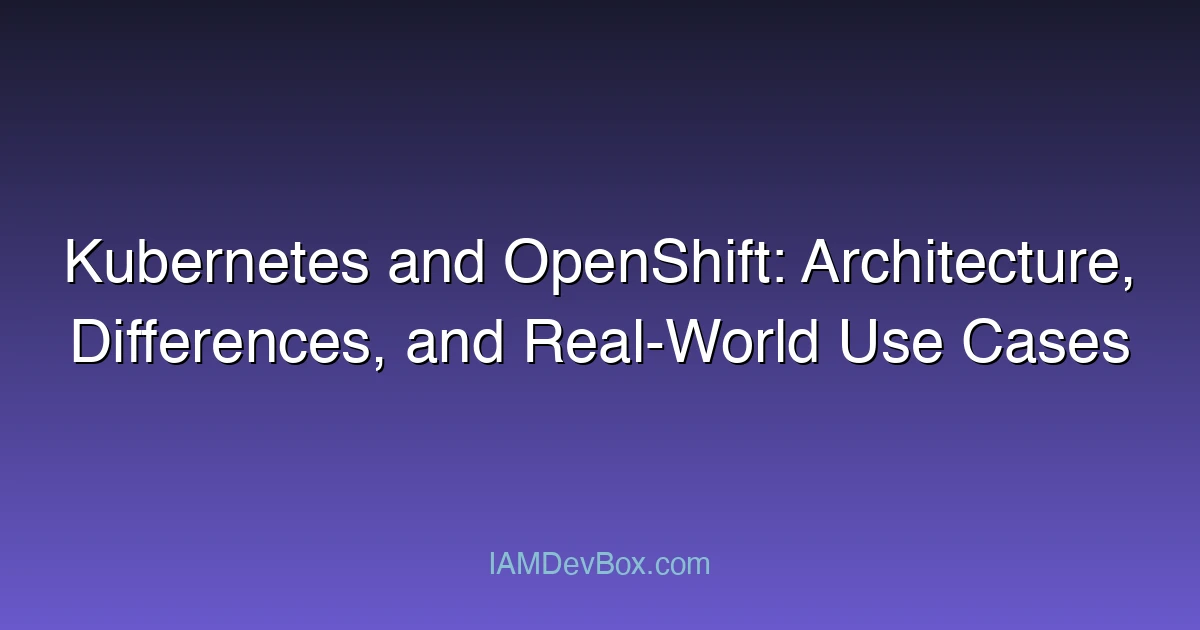Visual Overview:
graph LR
subgraph "CI/CD Pipeline"
Code[Code Commit] --> Build[Build]
Build --> Test[Test]
Test --> Security[Security Scan]
Security --> Deploy[Deploy]
Deploy --> Monitor[Monitor]
end
style Code fill:#667eea,color:#fff
style Security fill:#f44336,color:#fff
style Deploy fill:#4caf50,color:#fff
Introduction
As cloud-native development becomes the backbone of modern software delivery, two container orchestration platforms dominate enterprise adoption: Kubernetes and OpenShift. While Kubernetes is the de facto open-source standard, OpenShift—Red Hat’s enterprise-ready Kubernetes distribution—offers an integrated, opinionated stack for security, developer experience, and multi-cloud deployment.
This article unpacks the technical architecture, differences, and real-world use cases of Kubernetes vs. OpenShift, helping you choose the right platform for your DevOps goals.
Kubernetes Architecture Overview
Kubernetes is an open-source platform that automates the deployment, scaling, and management of containerized applications. Its architecture consists of:
[Clients] --> [kube-apiserver] --> [Controller Manager, Scheduler]
|
v
[etcd] ←→ [kubelet] ←→ [Pods]
↑
[Container Runtime]
Key components:
- kube-apiserver: Entry point for all control plane operations.
- etcd: Key-value store for cluster state.
- kubelet: Runs on each node to manage pods.
- kube-scheduler: Assigns pods to available nodes.
- Controller Manager: Manages replication, node health, and jobs.
- Container Runtime: e.g., containerd, CRI-O, or Docker.
Kubernetes is modular and extensible, which gives DevOps teams flexibility—but also requires managing a wide range of components and third-party integrations.
OpenShift Architecture Overview
OpenShift is a Kubernetes distribution with a comprehensive set of pre-integrated components. It includes all Kubernetes components plus additional enterprise-ready features:
[OpenShift Web Console] <---> [OpenShift OAuth]
↓
[Kubernetes API]
/ | \
[Image Registry] | [Operator Lifecycle Manager]
|
[Built-in CI/CD Pipelines]
Additions in OpenShift:
- Integrated OAuth authentication
- Built-in image registry
- Developer-friendly web console
- OpenShift Pipelines (Tekton-based)
- OperatorHub and OLM for lifecycle management
- Enhanced SCCs (Security Context Constraints)
OpenShift emphasizes secure-by-default configurations, reducing the operational overhead of securing and hardening a raw Kubernetes environment.
Key Differences Between Kubernetes and OpenShift
| Feature | Kubernetes (Upstream) | OpenShift (Red Hat) |
|---|---|---|
| Installation | DIY or kubeadm, kops, etc. | Assisted (OpenShift Installer, ROSA, ARO) |
| Authentication | External OIDC setup | Built-in OAuth server |
| Web Console | Optional via addons | Fully integrated, developer-friendly |
| CI/CD Integration | External (Jenkins, ArgoCD) | OpenShift Pipelines (Tekton) |
| Security Policies | PodSecurityPolicy (deprecated) | SecurityContextConstraints (SCC) |
| Container Runtime | containerd, CRI-O | CRI-O (preferred) |
| Developer Experience | CLI-focused (kubectl) | Web Console + oc CLI + Developer Catalog |
| Licensing | Open-source (Apache 2.0) | Open-source core + Red Hat subscription required |
Real-World Use Cases
1. Startups or Dev Teams Needing Full Control
Kubernetes offers complete flexibility for those who need to tune every aspect of the platform, especially on cloud-native stacks or managed services (GKE, EKS, AKS).
2. Enterprise IT Needing Compliance and Support
OpenShift shines in regulated environments (finance, healthcare) where built-in RBAC, audit logging, and certified software reduce risk and compliance costs.
3. Hybrid and Multi-Cloud Deployments
OpenShift has strong support for hybrid cloud setups (on-prem + cloud), with certified platforms like:
- ROSA (Red Hat OpenShift Service on AWS)
- ARO (Azure Red Hat OpenShift)
4. Developer-Centric Environments
Teams focused on application delivery (rather than infrastructure) often benefit from OpenShift’s developer tools, such as Source-to-Image (S2I), Dev Spaces, and Pipelines.
Deployment Models
Both platforms support various deployment options:
-
Self-Managed: On-prem or VMs
-
Managed Cloud Services:
- Kubernetes: GKE, EKS, AKS
- OpenShift: ROSA, ARO, OpenShift Dedicated
-
Edge Deployments: Lightweight K8s (K3s), MicroShift (OpenShift variant)
Container Security Considerations
OpenShift ships with more strict container policies out-of-the-box. For example:
- Containers cannot run as root by default.
- SCCs enforce constraints on what syscalls, volumes, and capabilities are allowed.
- An internal image registry with scanning can enforce supply chain integrity.
In Kubernetes, these must be configured manually with PodSecurityPolicies (now deprecated), OPA Gatekeeper, or Kyverno.
Developer Workflow Comparison
Kubernetes Workflow:
- Write Dockerfile and YAML
- Push to external registry
- Apply with
kubectl
OpenShift Workflow:
- Push source code to Git
- OpenShift builds with S2I or Pipelines
- CI/CD integrated with RBAC
This reduces YAML boilerplate and streamlines deployments in OpenShift.
🎯 Key Takeaways
- Controller Manager
- Container Runtime
- Integrated OAuth authentication
Conclusion
Kubernetes is a powerful and flexible orchestration engine that serves as the foundation for cloud-native workloads. OpenShift builds on this foundation by delivering an integrated, secure, and enterprise-grade platform.
Choosing between the two depends on your organizational needs:
- Go with Kubernetes if you need maximum control and customization.
- Choose OpenShift if you value out-of-the-box security, developer experience, and enterprise support.
Both are powerful tools—but OpenShift is Kubernetes with batteries included.
